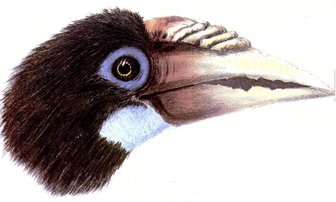Narcondam Hornbill
The Narcondam Hornbill is a species of hornbill in the Bucerotidae family. It is endemic to the Indian island of Narcondam in the Andamans.

The Narcondam Hornbill is classified as Endangered (EN), considered to be facing a very high risk of extinction in the wild.
The Narcondam Hornbill (Rhyticeros narcondami) is a species of hornbill in the Bucerotidae family. It is endemic to the Indian island of Narcondam in the Andamans. It is threatened by habitat loss. Since 2009 it has had a Conservation status of endangered. References - 1. ^ BirdLife International (2008). Aceros narcondami. In: IUCN 2008. IUCN Red List of Threatened Species. More
The Narcondam hornbill is a fairly small hornbill species, with a black body and distinct short, white tail. The sexes differ in appearance, with the larger male Narcondam hornbills having rufous plumage on their head, neck, and upper breast, whereas the females are black. The grand bill is yellowish-white with a dark crimson base (2), and atop the bill sits a horny ridge, or casque, a unique feature of all hornbills (4). More
Like many other hornbills (5), the Narcondam hornbill feeds mainly on fruit, with figs making up the majority of the diet (2). Their impressive beaks are used to reach ripe fruit, which is then tossed back into the gullet (5). At fruiting trees, groups consisting of up to 50 Narcondam hornbills may congregate (2). In addition to their curious beaks, hornbills are noted for their peculiar breeding habits (4). More
An extremely rare Narcondam Hornbill (Rhyticeros narcondami) that is confined to the Narcondam and Andaman Islands was photographed in early November 2008 at Singapore’s Bidadari Cemetery. This bird is obviously an escapee. After its sighting was posted, Joseph Lai was the first to respond, saying that he “saw this hornbill… flew overhead minutes before Minister Mah Bow Tan arrived at Sungei Buloh to officiate its inauguration as a Wetland Reserve (year 2002). More
Narcondam Hornbill? Indeed, will we allow them to do what we sent a posse of policemen to prevent Myanmar from doing – take the island away from India? Without vegetation holding it together, the volcanic rock will erode over time. Today it may sound fatalistic to say that an island devoid of vegetation might not survive the vagaries of tropical weather, but water and wind are an unstoppably potent force of erosion – and this, a one-way street to environmental disaster. More
Lt-Gen Baljit Singh (retd) on the Narcondam hornbill, which is found exclusively on this island of the Andamans Geographic isolation of life forms always triggers the development of species unique to that particular area, governed by an evolutionary phenomena called endemism. And the most dramatic evidence of endemism is, almost always, best demonstrated by the life found on an oceanic island that by geological definition has no physical link with any landmass, whatsoever. More
Narcondam Hornbill will certainly survive, in splendid isolation, on a wild volcanic outcrop jutting above the storm-tossed waters of the Bay of Bengal—the unquestioned icon of a potential Peace Park between India and Myanmar and a symbol of successful conservation. —Aasheesh Pittie 1Aitken, E. H. 1947. The common birds of India. 3rd ed. Bombay: Thacker & Co. Ltd. 2Vijayan, L. & Sankaran, R. 2000. More
Family : Bucerotidae
Genus : Aceros
Species : narcondami
Authority : Hume, 1873
